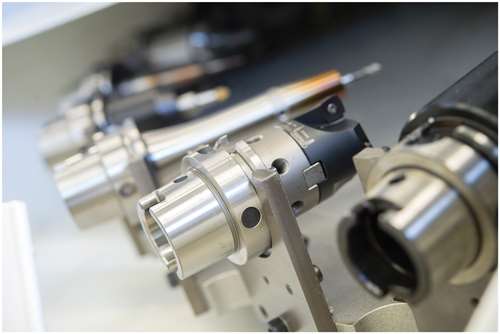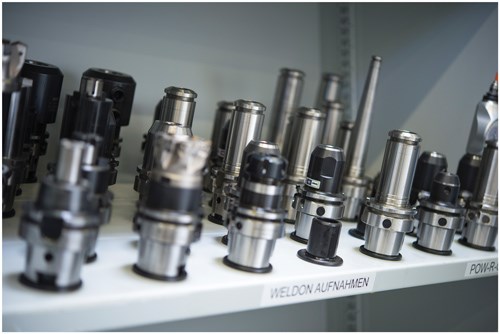Fast and Precise Tool Identification
The use of industrial identification in tool handling not only saves time and costs during recording, transmission and management of the tool data, but also increases manufacturing quality and machine tool productivity.
#workforcedevelopment
The use of industrial identification in tool handling not only saves time and costs during recording, transmission and management of the tool data, but also increases manufacturing quality and machine tool productivity.
Regardless of the type of the machine tool, such as turning, milling or grinding machines, the individual steps the respective tools run through are always similar. After receiving the production order, the machine operator selects the corresponding tools from the store. If necessary, he or she then assembles the toolholder and individual drill bits or milling cutters and determines the required geometrical tool data at the presetting and measuring device. Next, the operator inserts the tool into the tool magazine or the machine toolchanger and enters the tool data into the machine tool control.
Featured Content
The conventional approach to recording the tool data often still involves printing or writing it down on routing slips, labels or plastic signs attached to the tools and manually entering the data into the machine tool via the keyboard of the control unit. This procedure can cause a number of avoidable drawbacks relating to human error.
Quick and Error-Free
The use of RFID can offer decisive advantages over manual tool management methods. By automatically storing geometrical data on RFID transponders, which are permanently affixed to the tool, the tool data can be handled considerably faster and without errors. The clear identification and automatic data transmission to the machine tool control enable a quick and error-free tool change at the machine. Furthermore, the service life, actual and desired, as well as the early warning threshold can be stored directly on the RFID transponder at the tool and can be updated after loading and unloading. Maximum transparency can be realized and time consuming searches can be avoided by automatically registering the tools when putting them into or taking them from the store.
Perfectly Fitting Solutions
A range of solutions is available for the implementation of the appropriate RFID system, depending on the requirements of the respective machine tool type. In classic turning and milling applications that operate with toolholders possessing a DIN 69873 borehole, a widespread “tool pill” (such as the RFID transponder MDS D421 by Siemens) is used. The Siemens transponder is part of the portfolio of the RFID system Simatic RF200, which complies with ISO 15693. With a frequency of 13.56 MHz, the system offers a read/write distance between a few millimeters and several centimeters, depending on the selected transponder and reader as well as the installation in metal.
As a stationary read/write device, the compact RF250R reader can be used. For this reader, Siemens offers the small and rugged ANT8 antenna in an M8 metal housing, which is suitable for tight installation situations such as those found in tool magazines.
The handheld RF310M can be used for mobile reading of and writing to small transponders, such as the tool pill, in the tool store. The MDS D117 and D127 miniature transponders are available for very small tools or a space-saving installation. The MDS D117 is suitable for being glued flush into metal, and the MDS D127 with M6 screw housing can be screwed flush into metal.
Depending on the installation orientation in the machine tool, a longer read/write distance between the transponder at the tool and the permanently mounted RFID antenna may be required. The RFID system Simatic RF600 for UHF frequency band between 865 - 868 MHz (ETSI), 902 - 928 MHz (FCC) and 920 - 925 MHz (CMIIT) enables read/write distances up to several meters.
From mounting in and on metal, to use in higher temperature areas up to 425°F, to contact with aggressive or liquid substances such as cutting fluids, the large selection portfolio of RFID transponders offered by Siemens is designed to offer a solution for all environmental challenges.
Connecting to the Control
Another important issue that must be considered when selecting the appropriate identification system is the fast and easy integration into the machine control or into personal computer systems. For the connection to the machine tool control, the Siemens RFID read/write devices are offered with various interfaces, such as RS232 for direct connection or RS422 for the connection via communication modules to Profibus and Profinet fieldbus and/or Ethernet TCP/IP.
The application area of RFID systems for tool management is versatile. All industry sectors using machine tools can ultimately benefit from RFID installations, from the automotive and aerospace industries to power generation and medical technologies. More efficient tool handling and their data contributes to time and cost savings and helps to eliminate capital expenditures for unnecessary new
acquisitions.
RELATED CONTENT
-
Using Advanced CNC Technology to Overcome Labor Shortages
Many technology innovations in CNC machine tools can ease the burden of the skills gap, including the CNC lathes and multi-spindle machines from INDEX.
-
6 Tips for Training on a Swiss-Type Lathe
There are nuances to training a person to effectively operate a Swiss-type lathe. A shop I visited a while back offers some suggestions.
-
Re-Turning Adds Life to Train Wheels
Unique turning considerations and circumstances come into play when re-turning well-worn freight and metro rail wheels.








